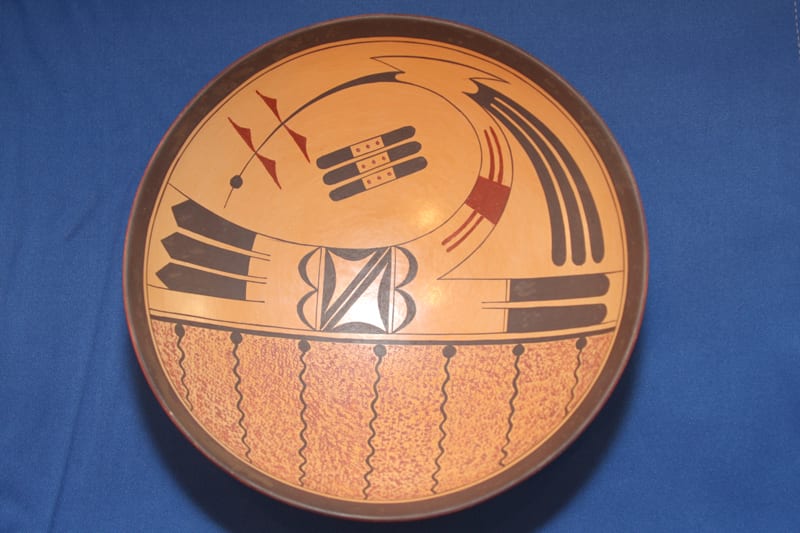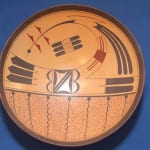Bowl 2010-23 is a variation of the “bird hanging from sky band” design of Sikyatki origin that was adopted by Nampeyo (see 1993-04) and became an iconic design for her (see Appendix B). Steve’s version is particularly elegant and delicate. Note that the entire outside of this bowl is finished in Steve’s red, micaceous slip. Pots finished with this slip require special treatment during firing: they are fired upside down, taking special care to avoid damage to the slip or the rim.
It is of course impossible to know the meaning (if any) attributed to the design by the Sikyatki potter who developed it 500 years ago. The term “bird hanging from sky band” was developed by Jessie Fewkes about 100 years ago (1919:242-249; 1973:140-147), and has no relation to any indigenous meaning of the design. Using an ancient Sikyatki bowl as a model, Nampeyo painted her version of this design as early as at least 1894. (See Appendix B.)
We do, however, know how the maker of bowl 2010-23 interprets its design:
This bowl is one of Steve’s more unusual pieces, he calls it his ‘Summer Pond, Tinaja’ bowl. There is a great deal of slick-rock on the Hopi mesas. When the summer rains come, little pockets in the rock, called “tinajas,” fill with rainwater, and the small pools come to life. Freshwater shrimp, water sprites and tadpoles hatch out. Dragonflies come along to take their fill. And this is the story behind this bowl. The top half of this bowl represents the dragonfly. The bottom half represents life under the surface of the water. (The word “tinaja” is from the Spanish word meaning cup, and a universal Southwestern term for the slick-rock pockets.)
This explanation was provided by Jay Tallant of Canyon Country Originals (Tucson, AZ) from whom Rutt bought bowl 2010-23 on 11/27/00. One assumes the explanation originated with Steve Lucas. The idea that when water comes the earth bursts with life certainly is central to Hopi religious belief.
Edward Abbey describes such tinaja in the southwest:
———-
All over the slickrock country there are natural cisterns or potholes…sculptured in the soft sandstone by the erosive force of weathering…. Many of them serve as little catchment basins during rain and a few may contain water for days or even weeks after a storm…set in naked rock (they) are usually devoid of visible plant life but not of animal life….(including) swarms of tadpoles…. (in O’Reilly 2001:87)
———-
This pot is one of a group of pots that were part of a 2,400-item Southwest pueblo pottery collection that was assembled by Rutt Bridges of Denver, CO over a period of about 14 years. His sister, Kathleen Hoff, is helping her brother sell the collection. In 2009 Kat sent me two CDs with information about Hopi pots in the collection. During 2010, over a period of months Kay sent me additional photographs of about 200 Hopi and Hopi/Tewa pots from the collection.



